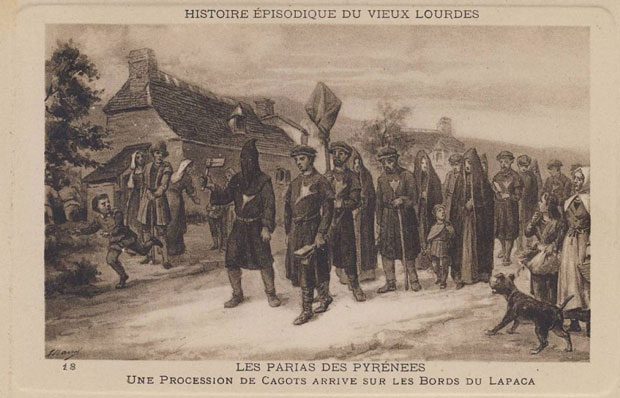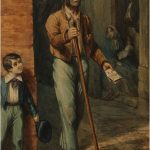
The Cagot people, a group with a mysterious and often misunderstood history, have long intrigued historians and anthropologists. Despite facing significant discrimination and social ostracism, the Cagots left a remarkable legacy through their art and craftsmanship. This article aims to uncover and appreciate the artistic contributions of the Cagots, particularly in architectural woodwork, stone masonry, and musical instrument crafting. By examining their work, we can gain a deeper understanding of their skills and the lasting impact they had on the regions they inhabited.
Historical Context of the Cagot People
The origins of the Cagot people are shrouded in mystery, with various theories suggesting they could be descendants of the Visigoths, lepers, or other marginalized groups. They primarily lived in southwestern France and northern Spain, notably in Béarn, Gascony, and the Basque Country. The Cagots were heavily discriminated against, often forced to live in segregated quarters and barred from many professions. This discrimination extended to religious practices, where they had to enter churches through separate doors and were confined to designated areas within the buildings.
The exact reasons for the discrimination against the Cagots remain unclear, but it was deeply rooted in societal norms and prejudices of the time. They were often subjected to various laws and restrictions, which limited their economic opportunities and social mobility. Despite these challenges, the Cagots managed to preserve their unique cultural identity and skills, passing them down through generations. Their resilience and adaptability allowed them to continue contributing to the local economy and culture in significant ways.
Documentation about the Cagot people is scarce, partly due to their exclusion from mainstream society and historical records. Much of what we know about them comes from local legends, oral histories, and the few written records that have survived. These sources often portray the Cagots in a negative light, reflecting the biases and prejudices of the time. However, modern research and scholarship are beginning to shed more light on their true contributions and experiences.
Understanding the historical context of the Cagot people is essential for appreciating their artistic legacy. It provides a backdrop against which their achievements can be measured, highlighting the obstacles they overcame and the impact they had on their communities. By examining the historical circumstances in which the Cagots lived and worked, we can better appreciate the significance of their contributions to art and craftsmanship.
Cagot Contributions to Architectural Woodwork
One of the most prominent areas of Cagot artistry is their work in architectural woodwork. Skilled as carpenters, Cagots were responsible for crafting intricate wood carvings found in many churches across southwestern France and northern Spain. Their work included creating detailed altarpieces, choir stalls, and other ecclesiastical furnishings, showcasing their remarkable talent and attention to detail. Notable examples of Cagot woodwork can be found in various churches, although specific attributions are often difficult due to the lack of records.
The stylistic elements of Cagot woodwork often featured elaborate geometric patterns and religious motifs. These designs not only demonstrated their technical skills but also their deep understanding of artistic expression and symbolism. Despite their significant contributions, Cagots rarely received credit for their work, as their social status prevented them from being recognized as master craftsmen. However, their craftsmanship had a lasting impact on local architecture, influencing the design and construction of many religious structures.
In addition to their work in churches, Cagot carpenters were also involved in the construction of various secular buildings. Their skills were in demand for creating intricate wooden ceilings, doors, and other architectural elements. The quality and craftsmanship of their work were highly regarded, even if their contributions were not always publicly acknowledged. This hidden legacy of Cagot woodwork can still be seen in some historical buildings that have preserved their original architectural features.
The techniques used by Cagot carpenters were often passed down through families, ensuring the continuation of their craftsmanship traditions. This knowledge transfer allowed for the refinement and development of their skills over generations. Despite facing social and economic challenges, Cagot artisans maintained a high standard of quality in their work, leaving behind a rich heritage of woodwork that continues to be admired today. Their contributions to architectural woodwork are a testament to their resilience and dedication to their craft.
Stone Carving and Masonry
In addition to their work in wood, Cagots were also known for their skills in stone carving and masonry. They played a crucial role in the construction and decoration of various buildings, particularly churches, where their stone carvings can still be seen today. These carvings often included intricate designs and motifs unique to Cagot artisans, such as elaborate capitals and friezes. Some notable structures are believed to feature Cagot stonework, though specific attributions are often unclear due to historical documentation gaps.
The stone carvings created by Cagot artisans were characterized by their precision and creativity. They often incorporated religious themes and symbols, reflecting the spiritual significance of their work. Despite their contributions, Cagots were often forced to work anonymously or under the names of other craftsmen due to the social stigma attached to their identity. Nevertheless, their stone carvings left a significant mark on regional building styles, contributing to the architectural heritage of the areas they inhabited.
Cagot masons were also involved in the construction of bridges, wells, and other public works. Their expertise in stonework was highly valued, and their skills were sought after for various building projects. The durability and quality of their stone constructions have ensured that many of these structures have stood the test of time. This enduring legacy of Cagot stonework highlights their important role in the development of local infrastructure and architecture.
The techniques and tools used by Cagot stone carvers were often passed down through generations, much like their woodworking counterparts. This tradition of craftsmanship allowed for the preservation and refinement of their skills, contributing to the high quality of their work. The artistry and technical proficiency of Cagot stone carvers continue to be admired today, serving as a lasting reminder of their contributions to the architectural heritage of their regions.
Musical Instrument Crafting
The artistic talents of the Cagots extended beyond architecture to the crafting of musical instruments. Cagot artisans were known for making high-quality lutes, harps, and other stringed instruments, showcasing their expertise in woodworking and fine craftsmanship. These instruments were highly valued for their sound quality and durability, reflecting the skill and dedication of Cagot craftsmen. Although fewer examples of Cagot-made instruments have survived to the present day, their reputation as skilled instrument makers was well-established during their time.
The techniques and materials used by Cagot artisans in crafting musical instruments were passed down through generations. This tradition of instrument making held cultural significance within Cagot communities, as music played an important role in their social and religious life. The craftsmanship of Cagot-made instruments often reflected the same attention to detail and artistic flair seen in their wood and stone work. Despite the challenges they faced, Cagot artisans managed to preserve and pass on their musical heritage, contributing to the cultural richness of their communities.
Musical instruments crafted by Cagot artisans were often used in local religious ceremonies and community gatherings. Their high-quality construction and superior sound made them prized possessions within the community. This tradition of instrument making not only showcased their craftsmanship but also played a role in preserving the cultural identity and traditions of the Cagot people. The surviving examples of Cagot-made instruments are a testament to their skill and dedication to their craft.
The influence of Cagot instrument makers extended beyond their immediate communities. Their reputation for quality craftsmanship meant that their instruments were sometimes sought after by musicians from other regions. This wider recognition of their skills highlights the broader impact of Cagot artisans on the musical culture of their time. The legacy of Cagot musical instrument crafting continues to be appreciated by those who study and play historical instruments today.
Artistic Legacy and Rediscovery
Efforts to document and recognize the contributions of the Cagot people to art and architecture have gained momentum in recent years. Scholars and local historians have been piecing together the fragments of Cagot history, bringing their achievements to light. Modern interest in Cagot craftsmanship has led to a renewed appreciation for their work, with some regions actively preserving and restoring sites associated with Cagot artisans. This growing recognition helps to honor the Cagot legacy and ensures that their contributions are not forgotten.
The preservation of Cagot art and historical sites has become an important part of regional heritage initiatives. By protecting and showcasing their work, communities can celebrate the artistic and cultural contributions of the Cagots. These efforts also provide valuable insights into the social history of the regions where Cagots lived and worked. As more research is conducted and more artifacts are uncovered, the story of the Cagot people continues to unfold, revealing a rich and complex heritage.
Modern exhibitions and museums have begun to include displays of Cagot art and craftsmanship, helping to educate the public about their contributions. These exhibitions often feature examples of their woodwork, stone carvings, and musical instruments, providing a tangible connection to their artistic legacy. Educational programs and workshops have also been developed to teach traditional Cagot techniques, ensuring that their skills are passed on to future generations. This renewed interest in Cagot art and craftsmanship is helping to preserve their legacy for years to come.
The recognition of Cagot contributions to art and architecture is not only important for historical accuracy but also for cultural preservation. By acknowledging and celebrating their achievements, we can ensure that the Cagot people are remembered and honored for their contributions. This recognition also serves as a reminder of the resilience and creativity that can flourish even in the face of adversity. The ongoing efforts to uncover and preserve Cagot art and craftsmanship are a testament to the enduring power of their legacy.
Personal Stories and Anecdotes
Individual stories of Cagot artisans offer a glimpse into their lives and the challenges they faced. Oral histories and anecdotes passed down through generations provide a more personal perspective on their experiences. These stories highlight the resilience and determination of Cagot craftsmen, who often worked in difficult conditions and faced social exclusion. Despite these obstacles, they managed to create beautiful and lasting works of art that continue to be admired today.
One such anecdote involves a Cagot carpenter who, despite facing severe discrimination, was known for his exceptional skill in wood carving. His work was so highly regarded that local church officials secretly commissioned him to create an altarpiece, knowing that revealing his identity would cause controversy. Another story tells of a Cagot stone mason who, through his intricate carvings, left a hidden signature in his work, ensuring that future generations would know of his contributions. These personal stories add depth to our understanding of the Cagot people and their artistic legacy.
These personal stories and anecdotes provide a human face to the broader history of the Cagot people. They illustrate the individual talents and contributions of Cagot artisans, highlighting their importance to their communities. These stories also serve as a reminder of the personal sacrifices and challenges that Cagot craftsmen faced in their pursuit of excellence. By preserving and sharing these stories, we can ensure that the legacy of Cagot artisans is remembered and celebrated.
The oral traditions and stories of the Cagot people have played a crucial role in preserving their history. These narratives have been passed down through generations, keeping the memory of Cagot artisans alive. As more research is conducted and more stories are uncovered, we gain a deeper appreciation for the contributions of the Cagot people to art and craftsmanship. These personal stories and anecdotes are an essential part of the Cagot legacy, providing a richer and more nuanced understanding of their history.
Conclusion
The Cagot people, despite the challenges they faced, made significant contributions to art and craftsmanship. Their work in architectural woodwork, stone carving, and musical instrument crafting showcases their exceptional skills and artistic talents. By uncovering and appreciating their legacy, we can gain a deeper understanding of their role in the cultural and artistic heritage of southwestern France and northern Spain. Recognizing and preserving their contributions is not only a way to honor the Cagot people but also to enrich our own appreciation of history and art.
As we continue to explore the hidden artistry of the Cagot people, we are reminded of the resilience and creativity that can thrive even in the face of adversity. Their legacy is a testament to the enduring power of art and craftsmanship, and their story deserves to be told and remembered. Through ongoing research and preservation efforts, we can ensure that the contributions of the Cagot people are recognized and celebrated for generations to come. By doing so, we honor not only their artistic achievements but also their indomitable spirit and cultural legacy.
The recognition of Cagot contributions to art and craftsmanship is a crucial step in ensuring their place in history. By shedding light on their achievements, we can correct historical inaccuracies and provide a more comprehensive understanding of their impact. The ongoing efforts to preserve and celebrate Cagot art and craftsmanship serve as a reminder of the importance of acknowledging and honoring the contributions of all individuals and communities. Through these efforts, the legacy of the Cagot people will continue to inspire and educate future generations.
References and Further Reading
- “The Cagots: France’s Untouchables” by Graham Robb
- “The Cagots of Béarn and Basque Country” by Jacques Blot




